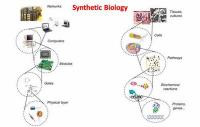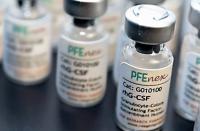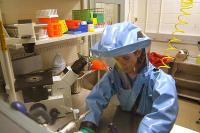-
Cloud-based biosurveillance ecosystem

The Departments of Defense and Homeland Security are developing a system which lets epidemiologists scan the planet for anomalies in human and animal disease prevalence, warn of coming pandemics, and protect soldiers and others worldwide.
-
-
Sharing of research data, findings should be the norm in public health emergencies

Opting in to data sharing should be the default practice during public health emergencies, such as the recent Ebola epidemic, and barriers to sharing data and findings should be removed to ensure those responding to the emergency have the best available evidence at hand, experts say.
-
-
“Kill switches” shut down engineered bacteria
Many research teams are developing genetically modified bacteria that could one day travel around parts of the human body, diagnosing and even treating infection. Before such bacteria can be safely let loose, however, scientists will need to find a way to prevent them from escaping into the wider environment, where they might grow and cause harm. To this end, researchers have developed safeguards in the form of two so-called “kill switches,” which can cause the synthetic bacteria to die without the presence of certain chemicals. This synthetic biology technique could make it safer to put engineered microbes to work outside the lab.
-
-
U.S. bioterrorism detection program unreliable: GAO
DHS’s BioWatch program aims to provide early indication of an aerosolized biological weapon attack. Until April 2014, DHS pursued a next-generation autonomous detection technology (Gen-3), which aimed to enable collection and analysis of air samples in less than six hours, unlike the current system (Gen-2), which requires manual intervention and can take up to thirty-six hours to detect the presence of biological pathogens. A GAO report found that DHS lacks reliable information about BioWatch Gen-2’s technical capabilities to detect a biological attack, and therefore lacks the basis for informed cost-benefit decisions about upgrades to the system.
-
-
Nanoparticle delivery maximizes drug defense against bioterrorism agent
Scientists have developed a nanoparticle delivery system for the antibiotic moxifloxacin that vastly improves the drug’s effectiveness against pneumonic tularemia, a type of pneumonia caused by inhalation of the bacterium Francisella tularensis. The scientists show how the nanoparticle system targets the precise cells infected by the bacteria and maximizes the amount of drug delivered to those cells.
-
-
DoD awards $7.6 million to Pitt to develop therapies against biowarfare
The U.S. Department of Defense (DOD) has awarded a $7.6 million grant to a collaborative group of scientists in the University of Pittsburgh Center for Vaccine Research (CVR) for work which could lead to countermeasures against bioterrorism attacks. The contract is the latest in a successful run of federal funding for this group of investigators within Pitt’s CVR, which the DOD acknowledges has performed well.
-
-
Centralized leadership, major reform needed to bolster U.S. biodefense
A comprehensive report on U.S. biodefense efforts calls for major reforms to strengthen America’s ability to confront intentionally introduced, accidentally released, and naturally occurring biological threats. The report details U.S. vulnerability to bioterrorism and deadly outbreaks and emphasizes the need to transform the way the U.S. government is organized to confront these threats. Recommendations include centralizing leadership in the Office of the Vice President; establishing a White House Biodefense Coordination Council; strengthening state, local, territorial, and tribal capabilities; and promoting innovation through sustained biodefense prioritization and funding.
-
-
Missouri schools underprepared for pandemics, bioterrorism, natural disasters
Pandemic preparedness is not only critical because of the threat of a future pandemic or an outbreak of an emerging infectious disease, but also because school preparedness for all types of disasters, including biological events, is mandated by the U.S. Department of Education. Missouri schools are no more prepared to respond to pandemics, natural disasters, and bioterrorism attacks than they were in 2011, according to a new study. Particular gaps were found in bioterrorism readiness — less than 10 percent of schools have a foodservice biosecurity plan and only 1.5 percent address the psychological needs that accompany a bioterrorism attack.
-
-
DHS S&T launches $100,000 prize competition to support NBAF facility
DHS S&T announced the National Bio and Agro-Defense Facility (NBAF) Think and Do Challenge, a prize competition that seeks ideas to leverage NBAF resources in order to conduct research to protect the nation’s animal agricultural industry and public health. S&T says that it will award up to $100,000 to help fund the development or implementation of winning submissions through the NBAF Think and Do Challenge, under the authority of the America COMPETES Act.
-
-
HHS in strategic alliance to accelerate new antibiotic development
Multiple drugs to combat bioterrorism threats and other life-threatening bacterial infections will be developed under a public-private partnership agreement between the U.S. Department of Health and Human Services’ Office of the Assistant Secretary for Preparedness and Response (APSR) and AstraZeneca, a global biopharmaceutical company. The partnership will also stimulates pipeline of drugs to treat multi-drug resistant bacterial infections. CDC has estimated that in the U.S. antibiotic-resistant bacteria are responsible for two million infections and 23,000 deaths annually with an estimated annual economic burden of $35 billion on the healthcare system.
-
-
U.S. defense agencies dominate federal synthetic biology research

A new analysis finds the Defense Department and its Defense Advanced Research Projects Agency (DARPA) fund much of the U.S. government’s research in synthetic biology, with less than 1 percent of total federal funding going to risk research. Between 2008 and 2014, the United States invested approximately $820 million dollars in synthetic biology research. In that time period, the Defense Department became a key funder of synthetic biology research. DARPA’s investments, for example, increased from near zero in 2010 to more than $100 million in 2014 — more than three times the amount spent by the National Science Foundation (NSF).
-
-
The history of biological weapons use
Few comprehensive, definitive histories of biological warfare have been written, many events reported in the literature never happened, and few details are available about some uses of biological weapons which most certainly did occur. A new review of the literature on actual and alleged instances of biological warfare finds that the incidence of illicit biological agent use has been greater than many people may realize, even as the effects have been relatively limited.
-
-
New book details safety, security methods for biosciences sites
Recent mishaps at laboratories which mishandled potentially dangerous biological substances and the transmission of the Ebola virus in a U.S. hospital are symptoms at bioscience facilities that two Sandia National Laboratories researchers think could be prevented by implementing the practices in a new book on biorisk management. The new book, Laboratory Biorisk Management: Biosafety and Biosecurity, is the first full-length manuscript on the detailed implementation of biorisk management.
-
-
Pfenex awarded contract valued at up to $143.5 million to develop anthrax vaccine

San Diego, California-based Pfenex Inc. the other day announced it has signed a five year, cost plus fixed fee contract valued at up to $143.5 million with the Biomedical Advanced Research and Development Authority (BARDA) of the Department of Health and Human Services (HHS), for the advanced development of Px563L, a mutant recombinant protective antigen anthrax vaccine. The company says the U.S. government is looking to have a stockpile of seventy-five million doses.
-
-
Researchers carefully protect dangerous pathogens – but how secure are all their data?

Ebola, smallpox, anthrax and many others: the most dangerous microorganisms are strictly regulated in the United States. The federal government oversees use of sixty-five so-called select agents with “the potential to pose a severe threat to public, animal or plant health, or to animal or plant products.” There has never been as much research performed with these pathogens —to learn more, find cures, or create vaccines — as in the past decade. The sprawl of high containment laboratories has led to a parallel increase in individuals with access to these agents. As of January 2015, approximately 11,000 individuals were on the list. The deadly infectious agents must be kept safely under lock and key, where they can’t threaten the general population or fall into the wrong hands. But even the most physically secure research lab could be the site of a devastating data security breach. As they stand now, information security guidelines published by science regulators with regard to select agents lack the critical level of detail needed to protect data effectively.
-
- All
- Regional
- Water
- Biometrics
- Borders/Immig
- Business
- Cybersecurity
- Detection
- Disasters
- Government
- Infrastructure
- International
- Public health
- Public Safety
- Communication interoperabillity
- Emergency services
- Emergency medical services
- Fire
- First response
- IEDs
- Law Enforcement
- Law Enforcement Technology
- Military technology
- Nonlethal weapons
- Nuclear weapons
- Personal protection equipment
- Police
- Notification /alert systems
- Situational awareness
- Weapons systems
- Sci-Tech
- Sector Reports
- Surveillance
- Transportation
Advertising & Marketing: advertise@newswirepubs.com
Editorial: editor@newswirepubs.com
General: info@newswirepubs.com
2010-2011 © News Wire Publications, LLC News Wire Publications, LLC
220 Old Country Road | Suite 200 | Mineola | New York | 11501
Permissions and Policies
Editorial: editor@newswirepubs.com
General: info@newswirepubs.com
2010-2011 © News Wire Publications, LLC News Wire Publications, LLC
220 Old Country Road | Suite 200 | Mineola | New York | 11501
Permissions and Policies
